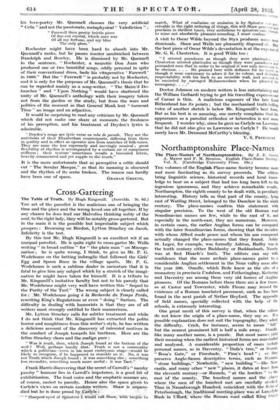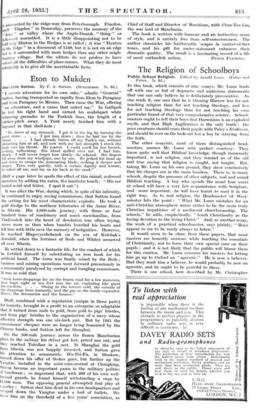Northamptonshire Place-Names
The Place-Names of Northamptonshire. By J._ E. Cover, A. Newer and F. M. Stanton. English Place-Name Society Vol. X. (Cambridge University Press. 18s.)
Ton volumes of the English Place-name Society become more and more fascinating as . its survey proceeds. The editors bring linguistic science, historical records and local know- ledg-e to bear on a subject that had too long been left to the ingenious ignoramus, and they achieve remarkable results. Northampton, the eighth county to be dealt with, is peculiarly interesting. History tells us that part of the county, lying east of Watling Street, belonged to the Danelaw in the ninth century. The place-naines confirm this statement with singular precision. To the west of the old Roman road Scandinavian names are few, while to the east of it, and especially in the north-east, they are numerous. Moreover, in certain cases, the earlier Anglian forms can be Compared with the later Scandinavian forms, showing that the invaders with whom Alfred made peace -and whom his son conquest(' actually changed the place-names that they found. Ashby St. Leger, for example, was formally Ashton, Badby was in the tenth century either Baddanby or Baddanburh, Naseby was at first Finaefe's burli. The editors can say with confidence that the more archaic place-names point to a considerable Anglian settlement inithe Nene valley soon after the year 500. Oundle, which Bede knew as the 'site of a monastery in provincia Undalum, and Fotheringhay, Kettering and Daventry are among these very old homes -of Anglian pioneers. Of the Romans before them there area few traces, as at Castor and Towcester, while Floore :may .record the existence of a Roman tesselated pavement; such as has been found in the next parish of Nether Heyfoid. The appendix of field names, specially collected with the help of the schoots, is extremely interesting.
One great merit of this survey is that, when the editors do not know the origin of. a place-name, they say so. If a possible explanation does not suit the topography, they adroit the difficulty. Crick, for instance, seems to mean " hilt" but the nearest prominent hill is half a mile away. (Muffle, like many another name, is a puzzle. But most names yield their meaning when the earliest historical forMs are marshalled and analysed. A considerable proportion of cases include personal names, as in Da.yentry, " Dafa's tree," or Bozeat, " Bosa's Gate," or Fineshade, A Finn's head " ;- or they preserve Anglo-Saxon descriptive terms, such as Stanion, " stone buildings," Newhottle, " new building "=like New- matte, and many other " new " .placen, it dates at least from the eleventh centuryor Raimds, " at the borders " to the east "..of the county. The hundred names and the platzs where the men of thehundred met are carefully studied. Thus in Nisaahoratigh Hundred, coincident with the Soke el Peterborough, the traditional ,Meeting-place 'was at LangdYke Bissh: in Ufforcl,- where --the Roman road called' Wing Street'
- intersected by the ridge-way from Peterborough. Finedon, t " Tingden " in Domesday, preserves the memory of the
• denu" or valley where the Anglo-Danish. " thing " or olk-meet assembled. It is a little disappointing not to be okl why Hinton in the Hedgesis so Called ; it was Hynton in the Edge " ina document of 1549, but it is not on an edge nor is it surrounded with more hedges than any other neigh- bouring village. But the editors do not profess to have solved all the difficulties of place-names. What they do most admirably is to give all the ascertainable facts.







































 Previous page
Previous page